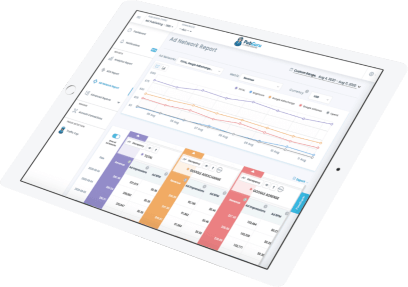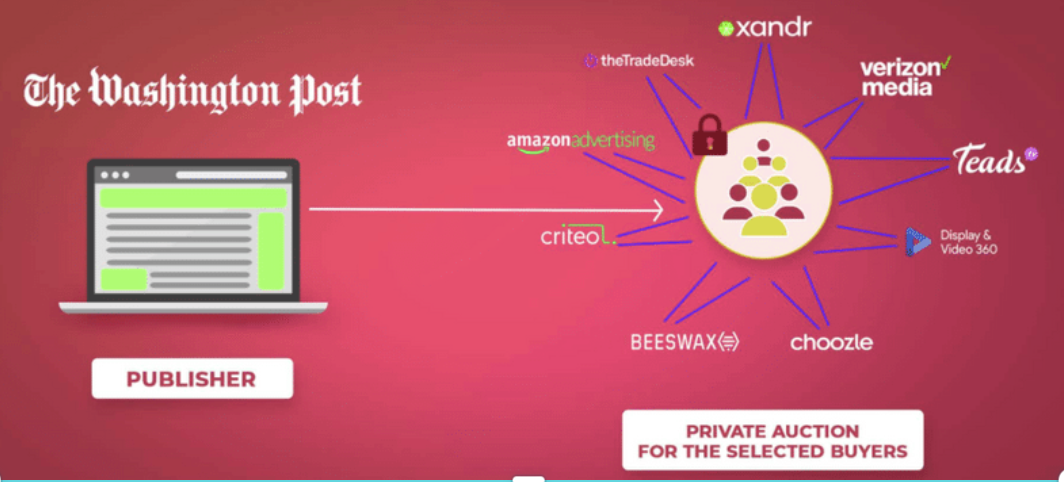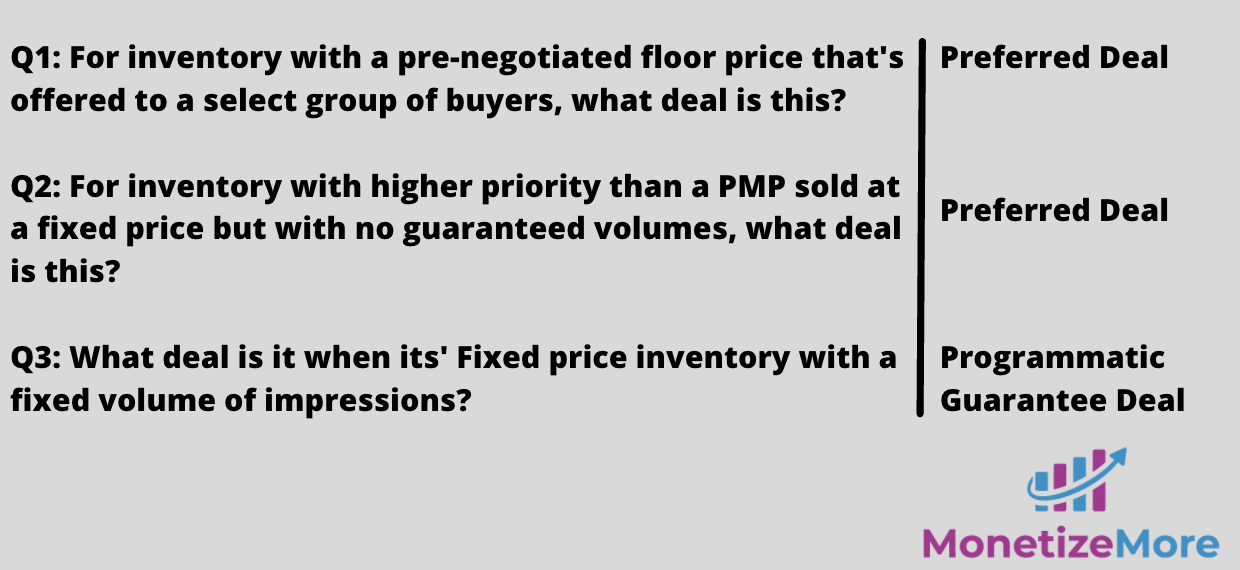What’s a PMP Deal and where does it fit in?
Private Marketplaces or PMPs are the latest way for publishers to sell ad space on their sites and it can be confusing. PMP is short for a “private marketplace” deal — it’s traditionally a deal made directly between a publisher and an advertiser or agency for programmatic inventory.
PMP Advertising allows publishers to invite advertisers of choice into private auctions where they can bid real-time ad inventory from vendors without any middlemen involved – all while maintaining control of quality standards that keep their customer base satisfied with every purchase made through them
Just because contact is made does not mean a deal will be struck. PMPs typically run at a higher priority than the managing SSP’s open auction.
This article will answer some of your questions about the benefits of using private marketplaces.
|
Unleash the full potential of programmatic advertising with Private Marketplaces (PMPs) and Preferred Deals! Get Started Here! |
What is a preferred deal? Is it the same as PMP?
Preferred deals are a more flexible option for negotiating a price with a specific advertiser but with less control over who else might see the ad space. PMPs offer publishers more control over who sees their premium inventory and the minimum price they’ll accept.
A preferred deal and a Private Marketplace (PMP) are related concepts in programmatic advertising, but they have some key differences:
Exclusivity:
PMP: More exclusive. In a PMP, only a select group of pre-approved advertisers can bid on the publisher’s inventory.
Preferred Deal: Less exclusive. Often involves just one publisher and one advertiser negotiating a fixed price for specific ad space, but the inventory isn’t guaranteed sold to that advertiser exclusively.
Pricing:
PMP: Publishers can set a higher floor price (minimum acceptable bid) for their premium inventory within a PMP.
Preferred Deal: The price for a preferred deal is negotiated directly between the publisher and advertiser, and can be lower than the floor price set in a PMP.
Inventory Guarantee:
PMP: Inventory isn’t guaranteed sold. If no advertiser in the PMP meets the floor price, the impression goes unsold or may be offered in an open auction.
Preferred Deal: Inventory also isn’t guaranteed sold. If the chosen advertiser doesn’t bid on the available inventory, the publisher can attempt to sell it elsewhere.
How do PMPs compare to programmatic guaranteed ad buying in terms of exclusivity and deal parameters?
PMPs (Private Marketplaces) and programmatic guaranteed (PG) ad buying have similarities but differ significantly in terms of exclusivity and the specifics of their deals. PMPs function as an exclusive marketplace where a publisher invites a shortlist of advertisers to bid on their inventory, offering a greater degree of control over who can access their audience.
In contrast, programmatic guaranteed involves a direct, one-to-one deal between the publisher and a specific advertiser who agrees to purchase a guaranteed volume of impressions at a fixed price. This means that in PG deals, the advertiser has exclusive rights to the inventory, making them the most exclusive form of programmatic buying.
In terms of deal parameters, PG deals tend to be more rigid, with the price, volume, and delivery dates for the ad impressions predetermined. Conversely, while floor prices are set in PMPs, there’s more flexibility for advertisers to adjust their bids based on campaign performance.
What are the main differences between PMPs and open market auctions in programmatic advertising?
The main differences between PMPs (Private Marketplaces) and open market auctions in programmatic advertising lie in exclusivity, inventory quality, and pricing. In an open market auction, any publisher can offer their ad inventory, and any advertiser can bid – it’s a free-for-all.
Conversely, PMPs are invite-only environments where a publisher handpicks the advertisers who are allowed to bid. This allows publishers to offer their premium inventory at higher floor prices, ensuring a better return. Moreover, PMPs encourage more transparent negotiations and can foster stronger relationships between publishers and advertisers compared to the anonymous nature of the open market.
Here’s a table outlining the key differences between open auctions (Open-RTB) and Private Marketplaces (PMPs) in programmatic advertising:
| Feature | Open Auction (Open-RTB) | Private Marketplace (PMP) |
|---|---|---|
| Model | Real-time bidding auction, open to all advertisers and publishers | Invite-only auction between a publisher and select group of advertisers |
| Price | Prices determined by highest bid | Negotiated prices or publisher-set floor price (minimum acceptable bid) |
| Inventory | Wider range of inventory, varying quality | Premium, high-quality inventory |
| Access | Open to any advertiser or DSP | Restricted to advertisers handpicked by the publisher |
| Transparency | Less transparency on inventory and pricing | More transparency on inventory, pricing, and advertiser identity |
| Control | Publishers have less control over who bids on inventory | Publishers have greater control over who accesses their inventory |
| Brand Safety | Increased risk of ads appearing next to undesirable content | Reduced risk of brand safety issues due to advertiser selection |
What Deal am I in?
What are the benefits of using PMPs?
Private Marketplaces (PMPs) offer publishers a toolkit to streamline ad sales, safeguard their brand, and maximize revenue.
A successful PMP requires a consistent supply of high-quality inventory to attract top advertisers. This is why PMPs are often best suited for established publishers with significant audiences.
Here’s why publishers turn to PMPs:
- Higher CPMs and Increased Revenue: Advertisers are willing to pay premium prices for targeted access to your audience within a PMP’s controlled environment.
- Enhanced Control and Brand Safety: You decide which advertisers can bid on your inventory, minimizing the risk of undesirable ads appearing on your site.
- Streamlined Advertising Operations: They automate many aspects of traditional direct sales, freeing up your team’s time and resources.
- Stronger Advertiser Relationships: They foster direct communication and negotiation with advertisers, building long-term partnerships.
- Future-Proofing Against Cookie Loss: They can help publishers establish direct audience connections, reducing reliance on third-party cookies.
The secret sauce to a Successful PMP deal?
To implement a PMP deal and get the results as expected, there are no shortcuts. However, our tips can keep you ahead of the competition:
1-Scoring the right Private Marketplace deal.
PMP deals vary based on the type and quality of inventory, the audience, and the buyer’s desired exclusivity.
The policies related to the first-party data shared, and URL transparency need to be optimal.
Let say your ad inventories in Google Ad Manager are labeled as “Branded” or “Semi-transparent” for Private auctions.
Semi-transparent allows buyers to see the main domain URL while Branded lets advertisers know where their ads will appear.
2-Analyzing the Open Auction Marketplace
We all know that CPM rates vary with the type of marketplace (i.e. open and private).
Since CPM rates vary all the time depending on an open or private marketplace, Open Auction marketplace offers an outlook of the latest market rates of the ad inventories.
Before setting up CPM rates and starting negotiations with buyers, make sure you analyze the ad inventory floor prices in the Open Auction marketplace.
Publishers can thus put the ideal & appropriate CPM rate in front of buyers and proceed with the sale.
3-Adapt to market changes
In the publisher’s marketplace, CPMs, bid rates, and bid density fluctuate with every season.
Ad spending starts increasing in Q4 even though Q1 and Q2 are hard times for the programmatic ad industry.
Thus, seasonality plays a critical role in establishing PMP deals.
How to optimize your Private Marketplace Deals?
Below are some actions and strategies to consider when optimizing a Private Marketplace deal:
Follow these suggestions for optimizing a PMP deal:
1-Transparency
Transparency is crucial. In either a header bidding or PMP setup, buyers are most likely to invest money where they can get detailed insights and better transparency.
This is why in PMP deals, DSPs acknowledge full domain URLs shared by the ad request. While DSPs will be able to target the base domain mainly, publishers can provide contextual relevance to buyers as part of their PMP deals & encourage targeting at both the content and ad placement levels.
2-Leveraging audience listings
In the PMP deals, publishers are allowed to share 1st-party data with the buyers. Alternatively, buyers can reserve ad inventories and ensure that each ad impression matches their 1st-party audience listings.
It’s a win-win to share the first-party data that you have to alleviate buyers’ pain points. Advertisers get their ROI, and publishers deliver better user experiences because visitors will see fewer irrelevant ads.
3-Adding customized ad displays
Both video & rich media creatives perform better than generic display creatives. PMP deals will benefit from a variety of ad formats including video, display, and native sizes along with rich-media ads.
Additionally, adding custom ad sizes or formatting that have a better impact across all kinds of devices for PMP deals also works. Ensure that the high-performing ad sizes are always kept at the higher floor price.
4-Optimizing ad viewability
Ad viewability is the key to success in Private Marketplace Ads and should not be passed over. It’s something you can’t afford to ignore if your long-term goals include maximizing revenue for PMP deals.
5-Leveraging roadblocks
While header bidding has created a fair platform by putting all buyers on the same footing, it has also diminished the priority of buyers who are exclusively looking for easy access to valuable ad inventories.
This is why PMPs were initially being introduced in the publishers’ marketplace. Take a look at Roadblock. Roadblocking allows a publisher to display ads from one advertiser on a single webpage at the same time.
That’s a 100% share of voice (SOV) for your advertisers.
6-Ad Relevance and better match rates
For header bidding, it is advised to have PMP partners on the client side. But why?
By enabling cookie-synching through your ad-tech partner, client-side header bidding offers better match rates. You can also use the key-value targeting feature in Google Ad Manager to amplify targeting.
Through key-value targeting, you can pass the post context, ad placement, etc., to advertisers and let them display their ads on the selected section or page.
How does MonetizeMore help enhance programmatic advertising for publishers?

Once you sign up for a professional account at MonetizeMore, you get instant access to pre-existing buyer deals and are invited to all private auctions (large-scale publishers mostly!). We do all the heavy lifting from setup to reporting.
What’s in it for you? More ad revenue can be yours with premium ads.
MonetizeMore’s PubGuru solution plays a vital role in revenue generation by granting direct access to demand from multiple DSPs, and demand partners in carefully curated deals co-managed through the PMP service.
Our AdOps experts collaborate closely 24/7 to create personalized advertising deals that align with their specific objectives. Publishers maintain full control over their campaigns while we take charge of setup and optimization, leading to desired ad revenue optimization.
Conclusion
PMPs are here to stay no matter what. By adopting and incorporating it into their media buying/selling strategies, it helps publishers, advertisers, and platforms grow. For brands, buyers, and agencies, there are multi-publisher PMPs available alongside traditional PMPs.
Both Open Marketplaces and Private Marketplaces offer the same benefits to publishers. Nonetheless, only publishers with a strong first-party data set can woo advertisers and conduct sustainable PMP auctions.
But what about mid-market publishers?
It can be difficult to make the most of PMP deals if you’re a mid-market publisher who is not part of an established network. We’ve scaled 1,500+ mid-market publishers’ ad monetization and set up an exclusive marketplace deal on their ad servers.
You will have access to pre-existing deals with larger premium sellers post joining the MonetizeMore network. Don’t wait any longer!
Forget about your current pain points and sign up for a professional account with us today.
FAQ
What is the difference between Programmatic guaranteed deals and preferred deals?
Both deals are very similar and are still a direct deal between the buyer and seller. However, with guaranteed deals, the publisher guarantees that a certain amount of impressions will be served while with preferred deals, there are no guarantees of impression volumes.
How can PMPs contribute to revenue generation for publishers?
PMPs can contribute to revenue generation for publishers as advertisers are willing to pay more for premium inventory, allowing publishers to charge higher prices and generate more revenue compared to open auctions.
What role does brand safety play in PMPs for publishers?
Brand safety is enhanced in PMPs as publishers have control over which advertisers can bid in the auction, reducing the risk of ad fraud and ensuring that the ads align with the publisher's brand values.
How do PMPs help publishers deliver an excellent user experience?
PMPs help publishers deliver an excellent user experience by connecting them to hyper-relevant advertisers, ensuring that the ads displayed are more targeted and relevant to users.
What are the challenges associated with using PMPs for publishers?
One of the challenges of using PMPs for publishers is the need to maintain high-quality inventory to keep buyers interested. Failing to do so can impact the publisher's bottom line and the effectiveness of the PMP auctions.
What is the projected growth of programmatic digital display ad spending, and how do PMPs play a role in this expenditure?
Programmatic ad spending is experiencing massive growth. It's expected to reach around $558 million in 2023 and continue growing, with projections suggesting it could surpass $700 billion by 2025. Programmatic digital display ads are the primary driver of this trend. In 2023, experts predict they will claim nearly 91% of all digital display spending. PMPs let publishers command higher CPMs for their top-tier inventory and encourage a more collaborative environment, beneficial for both publishers and advertisers.
The post What are Private Marketplaces? Lift CPMs & Advertiser Relations with PMPs appeared first on MonetizeMore.
source https://www.monetizemore.com/blog/private-marketplaces-pmp/






0 Comments